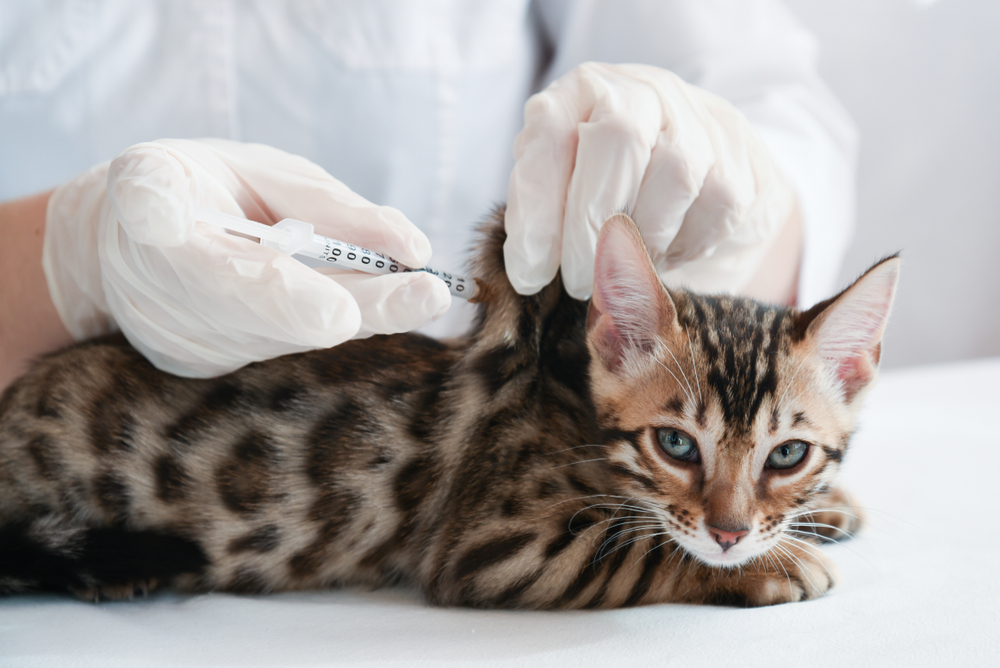Risk of Feline Injection Site Sarcoma vs. Vaccinations

The possibility of a feline injection site sarcoma can make some cat owners hesitate when it comes to annual vaccinations or other injections. They decide to avoid any vaccination risk and rely on the fact that their cats stay indoors. Vaccines are crucial though for most healthy cats to protect them from serious and sometimes easily transmitted fatal diseases. The risk of not vaccinating is much higher than the risk of this rare side effect, and recent research recommends other places on the body for vaccinations to avoid sarcoma risk.
It is important to weigh risks though; So one of the questions we get at Oakland Veterinary Referral Services is about feline injection site sarcoma. Let’s take a deeper look into this, the level of risk, and what you can do to protect your cat.
What Is Injection Site Sarcoma in Cats?
A feline injection site sarcoma is a tumor that is in the connective tissues. These tumors, known as fibrosarcomas, occur between the shoulder blades, hip region, and back legs. The type of cells affected are referred to as fibroblasts.
There is a correlation between injecting certain vaccines in these areas of the body, including the rabies and feline leukemia (FeLV) vaccines. Another possible cause of this sarcoma is antibiotic injections and ongoing injections from other forms of treatment. Also, there is a possible genetic element for those cats who develop feline injection site sarcoma, but we need more studies before we can isolate that particular genetic predisposition.
Diagnosis and Treatment
Fibrosarcomas can show up within months of an injection or many years later. Most are isolated tumors, firm to the touch, and not freely moveable. These fibrosarcomas are less likely to spread than other forms of cancer and the perimeters of the mass is easier to distinguish. Many times, the pet owner will find these lumps while petting or grooming their cats.
To obtain a diagnosis, we would call for a CT scan to look at the size, location, and edges of the tumor to get a better understanding of how to remove it. We will also perform a biopsy using a fine needle to examine some of the cells. While most of these sarcomas are localized, there are some, an estimated 25%, that spread to the lungs or other organs. This is why an x-ray of the chest is important in creating the most effective treatment plan.
Surgical removal of these tumors is the best form of treatment. In this case, the surgeon would perform a full biopsy to examine the mass. Post-surgery we will review the area of the site and decide whether or not we need to use radiation to eliminate any remaining cancerous cells. This is also necessary when the cancer is more aggressive. Chemotherapy is another recommended form of treatment for many of our sarcoma patients. This is because there is a high recurrence rate (up to 84%) with surgical excision alone.
Prognosis for cats diagnosed with feline injection site sarcomas varies; However, when it is detected early and treated aggressively, the survival rates improve substantially. Furthermore, cats who develop feline injection site sarcoma should avoid future vaccinations.
Prevention of Injection Site Sarcoma in Cats
The risk of your cat developing this form of cancer is still relatively rare. We now have a better understanding of the causes of these sarcomas so we can continually improve the safety of vaccines, but they are not yet 100% safe. This is why we recommend tailoring vaccine programs to the individual cat. We consider many factors in the decision to vaccinate and how often, including age, health, and underlying risk factors. The good news is that most healthy kittens and cats are at very low risk for developing injection site sarcomas.
Call us if you would like additional information on feline injection site sarcoma and how to best protect your precious pet.


